This spring, we will again celebrate holders of master’s and doctoral degrees in solemn conferment ceremonies organised by University of Helsinki faculties. Our University has a long history of conferment ceremonies: the first such ceremony took place at the Academy of Turku (now the University of Helsinki) as early as 1643. To celebrate the festivities this spring, our object of the month is one of the many mementoes of previous ceremonies in our collections, a picture of the participants in the conferment ceremony of the Faculty of Philosophy in 1894.
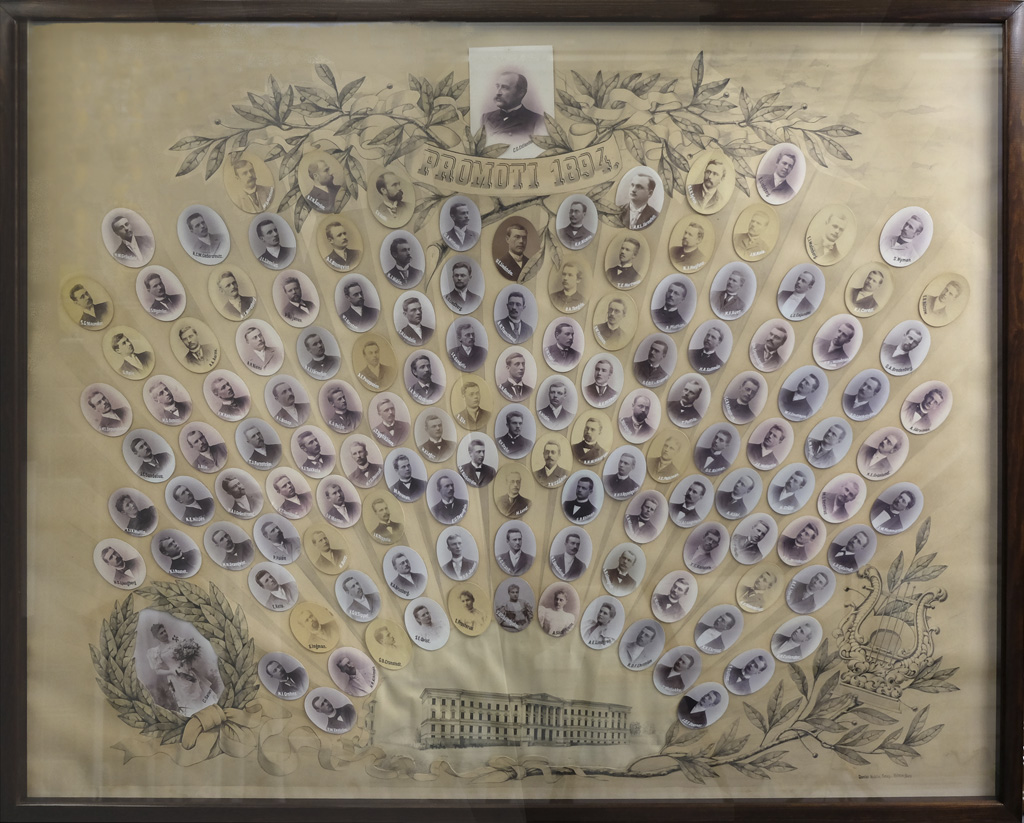
Photo: Helsinki University Museum / Anni Tuominen
Similar conferment pictures were customary from the late 19th century to the 1950s. The collections of the Helsinki University Museum include a total of eight such pictures, the oldest from 1890 and the most recent from 1957. Photos of graduands have also occasionally been compiled into an album, which has been presented as a commemorative gift to the official garland-weaver.
Conferment picture of 1894
Surrounded by a wooden frame, the picture features photos of serious-looking young people arranged in the shape of a fan. The photos are mostly of master’s graduands, but some are of persons who were conferred both a master’s and a doctoral degree at the same time. At the top of the picture is a photo of Carl Gustaf Estlander, the conferrer, and at bottom left is a photo of Gertrud Saelan, the official garland-weaver, who supervised the weaving of the master’s garlands. A laurel wreath and some leaves as well as the University’s Main Building have been hand-painted in watercolour on the cardboard. The photographs were taken and the decorative cardboard created by Daniel Nyblin’s photography studio.
The picture described in this blog article was donated to the University of Helsinki by Taivassalo-seura (Taivassalo Society) in May 1992. The society was established in 1960 to collect objects associated with the history of the Taivassalo region. Ten years later, the society opened a museum in Viiainen Manor, which was built in the late 18th century. The museum is open six days a week in the summer, and the manor can also be explored through a virtual tour on the society’s website.
The conferment picture belonged to the previous owner of the manor, Arthur Wittfooth. He was conferred a master’s degree in 1894, when he also served as the chair of the conferment committee. Available sources do not provide information on how the picture came to be in his possession, but it is possible that he had received it as a gift from the graduands.
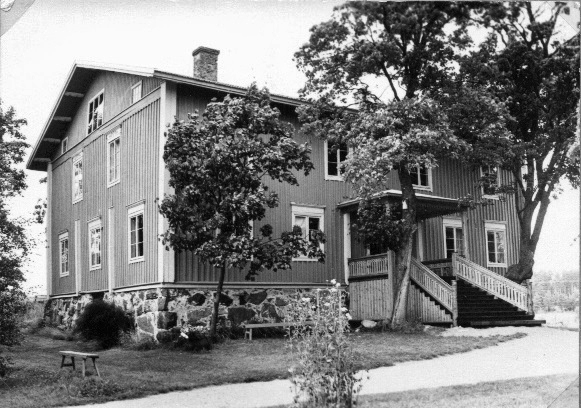
The tradition of conferment ceremonies in brief
Conferment ceremonies are among the most distinctive and significant celebrations of our University, and have been organised by various faculties since the 1640s. The history of such ceremonies in Europe stretches back to the 13th century when the oldest universities in Bologna and Paris began to hold solemn celebrations for the awarding of academic degrees. In Finland, the tradition of conferment ceremonies has been listed in the National Inventory of Living Heritage.
During the ceremony, the graduands are presented with the insignia of their degree: a laurel wreath and a gold ring to the master’s graduands and a doctor’s hat and a sword to the doctoral graduands. The laurel wreath symbolises victory over the demands of studies, whereas the sword symbolises strength and intellectual freedom. At the Faculty of Theology, doctoral graduands receive a Bible instead of a sword.
In addition to master’s and doctoral graduands, the participants in a conferment ceremony include jubilee masters and jubilee doctors, who are re-conferred the degree they were conferred 50 years earlier. Particularly distinguished individuals can also be conferred an honorary doctorate regardless of their educational background.
The conferment festivities last several days and include a garland-weaving session, a sword-whetting ceremony, the actual conferment ceremony, a dinner, an excursion and a ball, all taking place in their traditional order. The festivities include specific roles for garland-weavers, master’s and doctoral graduands, the conferrer, the chair of the conferment committee, the master of ceremonies, and the highest and second-highest ranking master’s and doctoral graduands. The highest ranking master’s graduand is the person who received the highest grade for their master’s thesis, whereas the second-highest ranking master’s graduand is the person who received the second highest grade. The various events and activities associated with the conferment festivities also include speeches as well as readings of poetry and performances of music commissioned for the occasion.

Conferment ceremony of the Faculty of Philosophy in 1894
The conferment ceremony of the Faculty of Philosophy in 1894 was attended by 16 doctoral and 139 master’s graduands, of whom approximately half were Finnish speakers. Finnish began to be used alongside Swedish for the first time in the publications associated with this ceremony. Closer examination of the individuals in the conferment picture reveals an interesting network of academic families, which was still fairly closed-off at the time. However, the network gradually began to expand as Finnish speakers, such as the sons of farm owners, sought to educate themselves.
The conferrer was Carl Gustaf Estlander, Professor of Aesthetics and Contemporary Literature, who also played an important role in the acquisition of the University’s art-historical sculpture collection. In addition to his academic career, Estlander served as a member of parliament, was active in the Finnish Antiquarian Society and the Finnish Art Society, and took the initiative in the establishment of the country’s highest art education institution, the Ateneum.
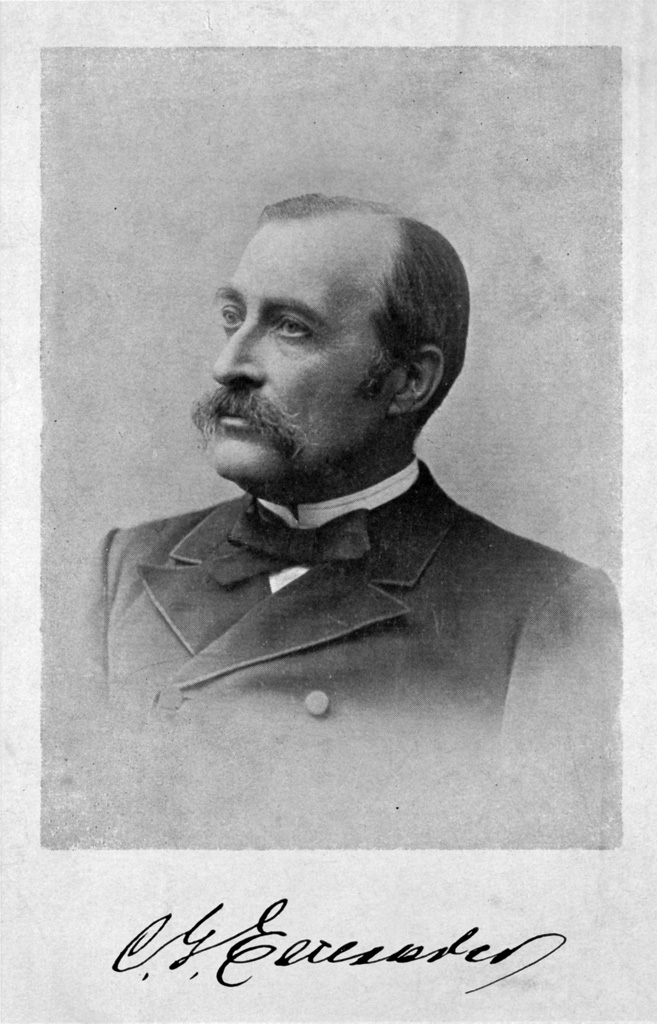
Usually, the daughter or son of a professor is invited to act as the official garland-weaver. Over the years, the role has been carried out by the daughter of C.G.E. Mannerheim, Regent of Finland, and the granddaughter of Urho Kekkonen, President of Finland. In the conferment ceremony of 1894, the official garland-weaver was Gertrud Saelan, daughter of Professor Thiodolf Saelan. Professor Saelan served as the chief physician of the Lapinlahti Hospital and was the most prominent expert in psychiatry and the treatment of mental illness in his time. He was awarded the title of professor in 1877. Gertrud Saelan married the artist Väinö Blomstedt in 1911. Blomstedt worked, for example, as a teacher at the University’s Art Room. Participating for the first time in 1894 was a jubilee garland-weaver, Sofia Tengström (later Sofia Kellgren), who had served as garland-weaver 50 years earlier. Her husband was Herman Kellgren, Professor of Oriental Literature, her father was Johan Jakob Tengström, Professor of Philosophy, and her great-uncle was Archbishop Jakob Tengström.
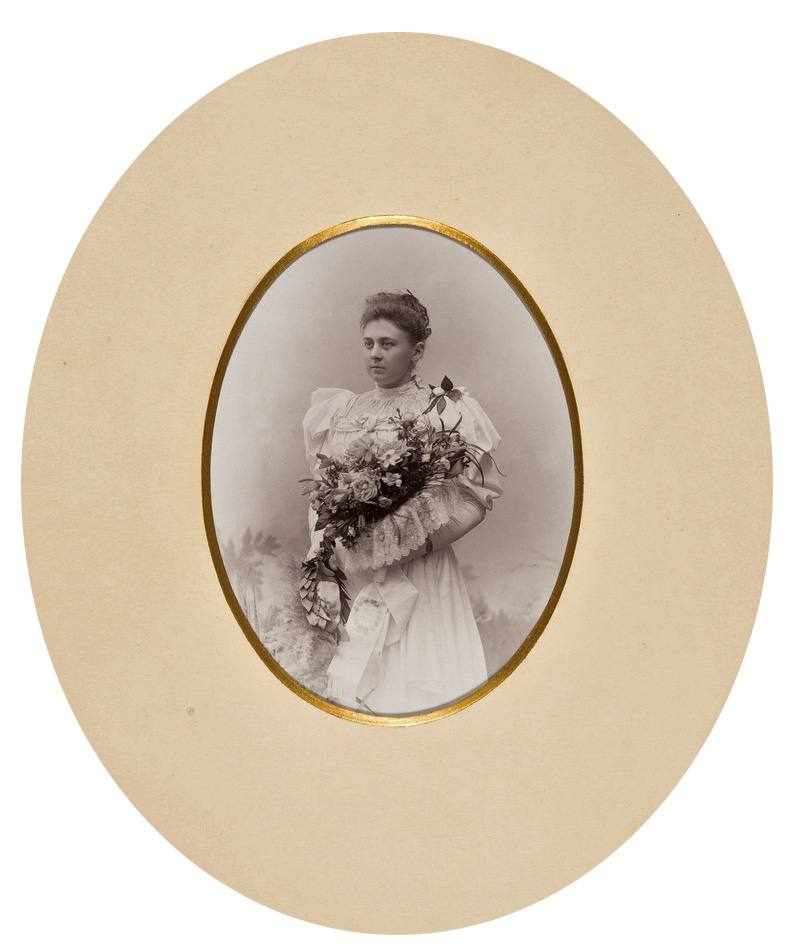
Many interesting individuals are connected to the conferment ceremony of 1894: the new conferment cantata was composed by Jean Sibelius, who was the University’s acting music teacher at the time, and it was performed by, among others, the young, talented soprano Aino Achté. The lyrics for the cantata were written by Kasimir Leino, the brother of noted Finnish poet Eino Leino. The Swedish-language conferment poem was written by author and poet Zachris Topelius.
Selected graduands
Siblings Alma and Sanny Söderhjelm were both conferred master’s degrees. They were the daughters of W.W. Söderhjelm, a senior judge and senator, and originally from Vyborg. Sanny later became a mathematics teacher, whereas Alma pursued an academic career as a historian, examining the French Revolution of 1789, in particular. In 1928 Alma Söderhjelm was appointed Professor Extraordinary of History, a newly endowed chair established at Åbo Akademi University, thus becoming the first woman to hold a professorship in Finland.
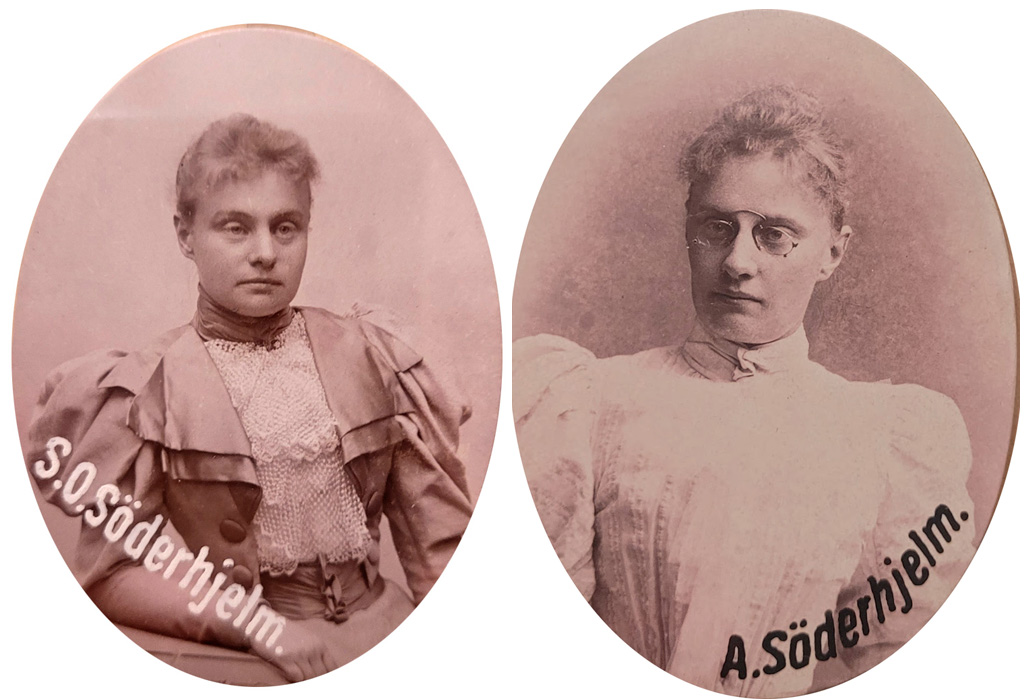
The Sodankylä-born Santeri Ivalo (originally Herman Aleksander Ingman) was conferred both a master’s and a doctoral degree. He later became a well-known journalist, member of parliament and author. He was involved in the establishment of the Päivälehti daily (now Helsingin Sanomat) and also served as its editor-in-chief. His historical novels, such as Juho Vesainen, were highly popular in their time.
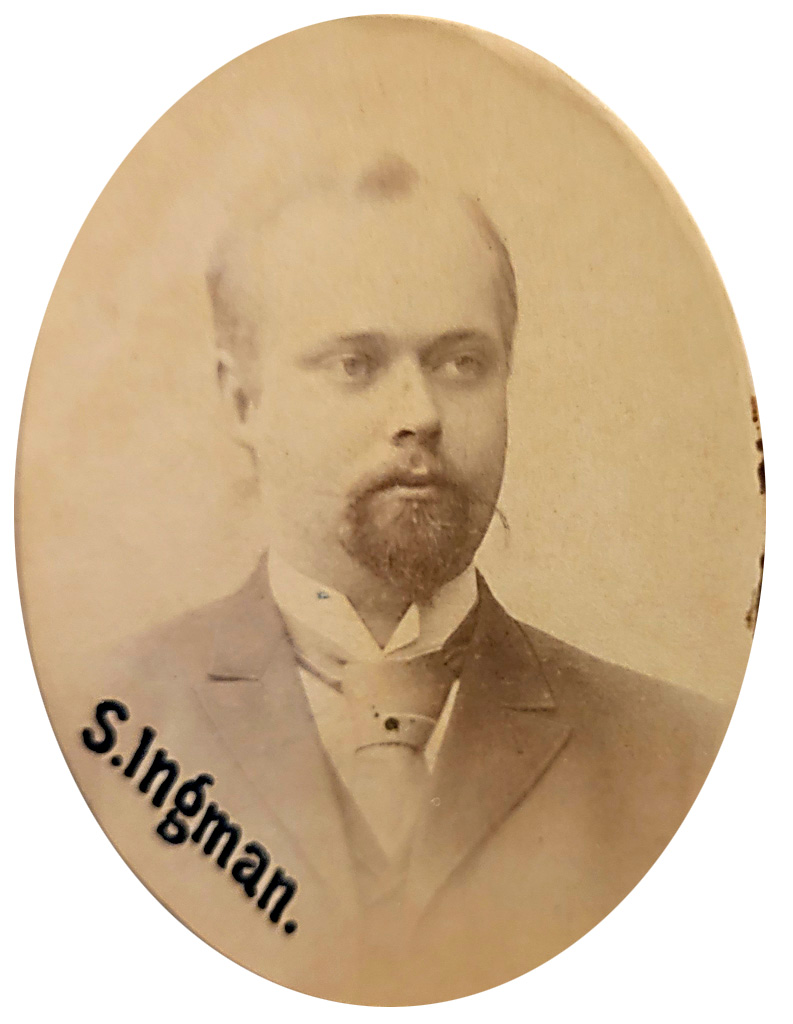
Torsten Evert (Tor) Karsten, the Orivesi-born son of a clergyman, was first appointed Professor of Germanic Philology and later Professor of Nordic Philology. His research focused on topics such as cultural influences between Finns and Germanic peoples over a period of 3,000 years as well as Swedish-language place names in the Ostrobothnia region of Finland.
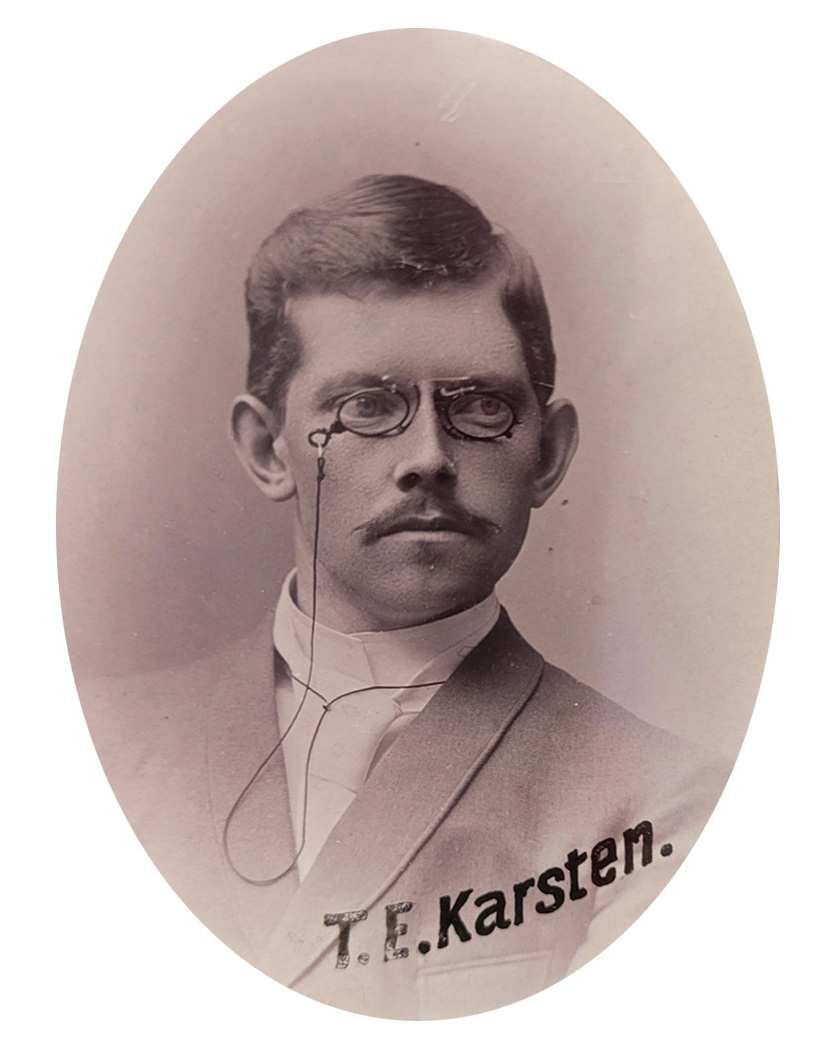
Akseli Kustaa Leonard Järnefelt (later Rauanheimo) was born the son of a rural police chief in Nurmes. He made his life’s work as a journalist and an advocate of Finnish immigrants to the United States. He lived in the United States in the 1890s and served as Consul General of Finland in Canada from 1923 to 1932.
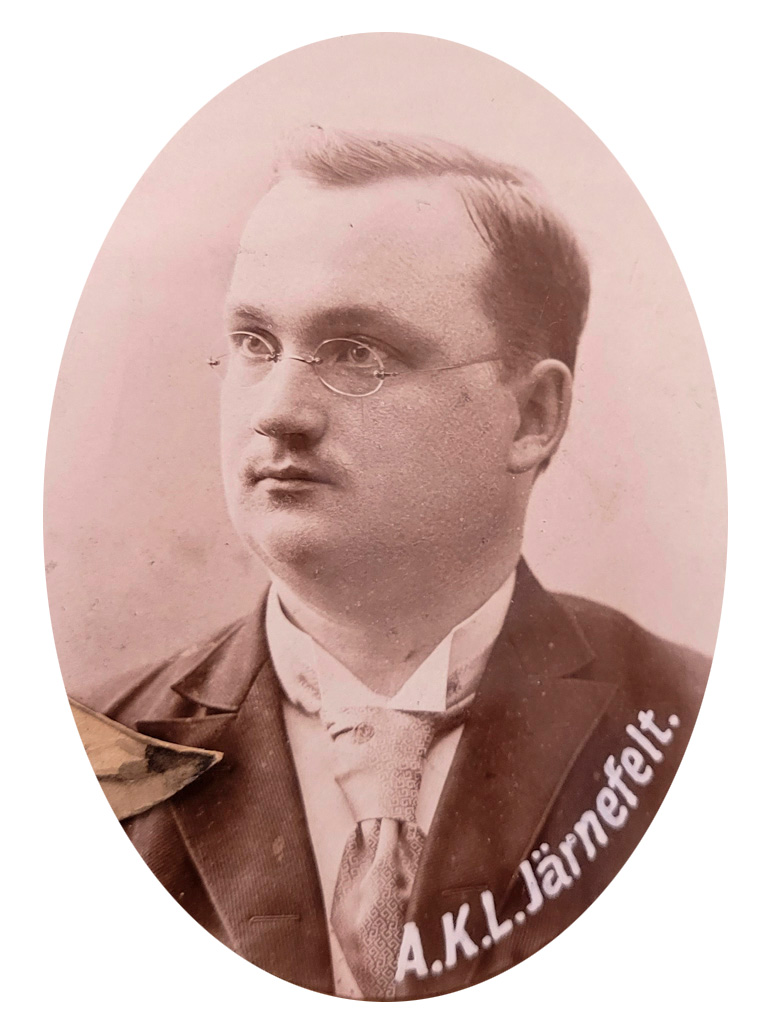
The conferment ceremony of 1894 was historical not only because Finnish was used as an official conferment language, but also because it was the first time that women were conferred degrees. Of the total of six women graduands, the Söderhjelm sisters were mentioned above, and another graduand was Tekla Hultin, who has been presented previously in our blog: Tekla Hultin – always at the heart of the action
Jaana Tegelberg, Head of collections
Translation: University of Helsinki Language Services.
Sources:
Akseli Rauanheimo. Article in Kansallisbiografia, the National Biography of Finland [website]. [Accessed on 21 March 2022.] Available at https://kansallisbiografia.fi/kansallisbiografia/henkilo/1655.
Bagge, Taina: Promootiot Helsingin yliopistossa 1832–1967. Helsingin yliopiston historian laitoksen julkaisuja n:o 5. Helsinki 1974.
Bernhard Estlander [Sanny Söderhjelm’s husband]. Article in Kansallisbiografia, the National Biography of Finland [website]. [Accessed on 21 March 2022.] Available at https://kansallisbiografia.fi/kansallisbiografia/henkilo/4998.
Elävä perintö. Maistereiden promovoiminen [website]. [Accessed on 21 March 2022.] Available at https://wiki.aineetonkulttuuriperinto.fi/wiki/Maistereiden_promovoiminen.
Ilmakunnas, Johanna (ed.): Promootio akateemisena juhlana. Helsingin yliopiston filosofisen tiedekunnan promootio 2010. Promotionen – en akademisk fest. Filosofiska fakultetens vid Helsingfors universitet promotion 2010. Promotio ordinis philosophorum Universitatis Helsingiensis MMX. Suomalaisen Kirjallisuuden Seura. Helsinki 2011. Suomalaisen Kirjallisuuden Seuran toimituksia, 1317.
Inbjudning till de Magister- och Doktors-Promotioner, hvilka af filosofiska fakulteten vid Kejserliga Alexanders-Universitetet i Finland komma att med sedvanliga högtidligheter anställas i Helsingfors den 31 maj 1894. [University of Helsinki] 1894.
Klinge, Matti; Kolbe, Laura: Suomen Ylioppilas. Keuruu 1991.
Santeri Ivalo. Article in Kansallisbiografia, the National Biography of Finland [website]. [Accessed on 21 March 2022.] Available at https://kansallisbiografia.fi/kansallisbiografia/henkilo/2819.
Santeri Ivalo. Wikipedia article [website]. [Accessed on 21 March 2022.] Available at https://fi.wikipedia.org/wiki/Santeri_Ivalo.
Taivassalo-seura. Muistelmia seuran ja museon alkuvaiheista 1/2 [website]. [Accessed on 7 March 2022.] Available at https://www.taivassalo-seura.fi/?page_id=1260.
University of Helsinki Archives. Documents related to conferment ceremonies, 1894–1919.
Ylioppilasmatrikkeli 1853–1899 [website]. [Accessed on 7 March 2022.] Available at https://ylioppilasmatrikkeli.helsinki.fi/1853-1899.
